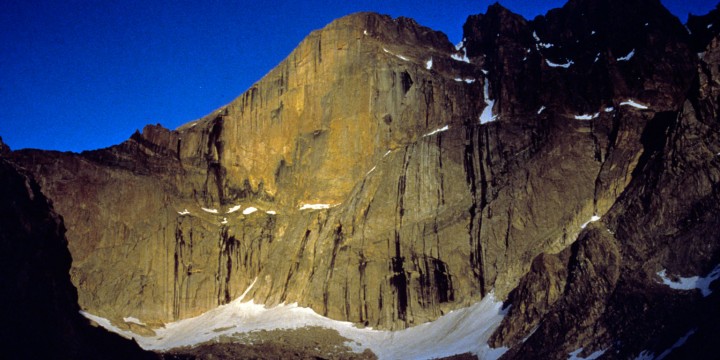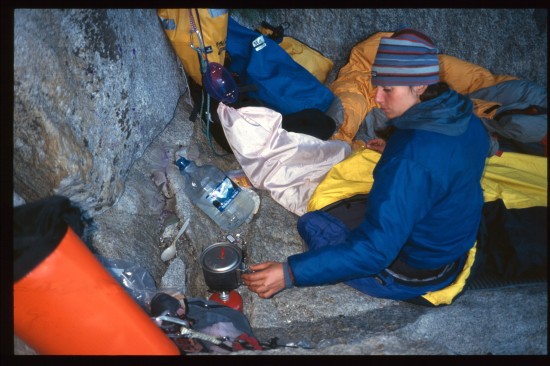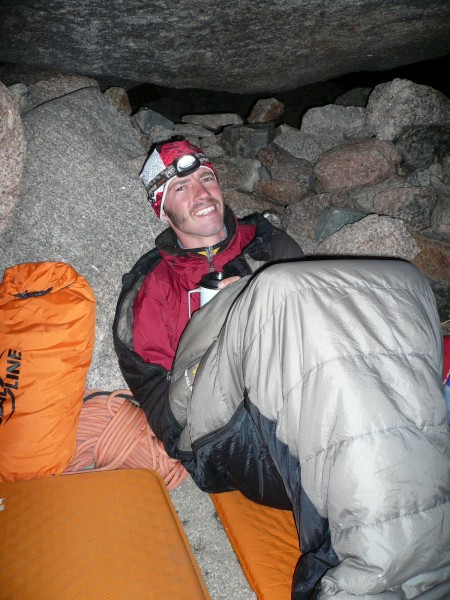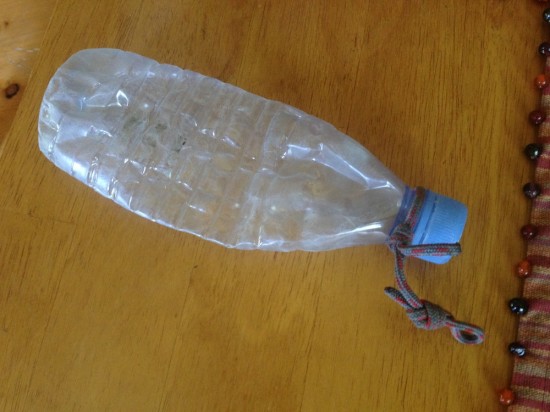
Light is Right: Sleeping, Eating and Drinking
- June 2013
- Climb
The summer season is the time to get up in the mountains for alpine rock adventures. Fun and success are directly related to preparation, and equipment matters a lot. I have always been obsessed with saving weight on long routes. The smaller you are, the more it matters, but everyone will feel stronger and climb better if they can reduce what they are carrying.

For most alpine rock routes, you will either get the super alpine start and do the approach, climb and descent in a day, or you will hike up the day before, bivy and climb the next day (with a possible second bivy before going down). Either way, you should reduce weight as much as possible for each part of the outing. I go as minimalistic as possible for the bivy, with only what I need to be comfortable and no more, because I don’t want to carry a huge load up there and be tired the next day for the climbing.
Sleeping:
I use a lightweight Thermarest pad with a superlight sleeping bag. Because I’ll bring a very light puffy vest or jacket, I’ll plan to sleep with most of my clothes on if the bag is too light. This is one thing you could go heavier on, but really think about the total of clothing + bag as a possible way to take a lighter bag. Where this is not so nice is that you won’t be able to stuff the puffy inside a shirt to make a pillow (sounds silly, but kind of a big deal). I use the rope and stuff my ultralight windbreaker inside a shirt, and it’s not luxurious, but hey, it’s a bivy.
If you know you will have a rock cave, you may choose to go without a bivy sack. I am a HUGE fan of the Ortovox Biwaksack. It weighs less than some chocolate bars, and you can wear it like a raincoat, get under it on a sitting-room only ledge with your partner, sleep in it like a normal bivy sack, make a sun/snow shelter out of it on a big wall or at a bivy, and signal for help with it (hopefully not). It can also contribute to pillow stuffing if you’re not using it for other needs. I’ve done all of the above except for the help signaling. I actually have 3 of them because it’s my favorite thing ever (one is full of holes now)–they cost about $90, and yes it is totally worth internet searching and ordering it from Europe. Be forewarned though, it is inexpensive and light because it is coated nylon, so it will not breathe at all, so use it accordingly. Always bring a dry pair of warm socks for sleeping, and a dry underlayer that you can change into after the approach.
Bring the smallest headlamp you can with a brand-new battery. I like the Mammut S-Lite.

Eating:
This is some of my other most favorite gear on the planet!!
Bring an MSR Microrocket stove with a small fuel cartridge (if you are only going for one or 2 nights). You won’t be cooking so much as making water hot, and be very stingy with the fuel. This stove is unbelievably light and has a sparker (but I am paranoid so I bring a tiny lighter too). Words actually can’t describe how happy I am with that stove and the Titanium Tea Kettle (which is also a pot/bowl when you are me). Because they’re light! For dinner (soup/noodles) and breakfast (tea/muesli), I just boil the water and then put the food in there with the lid on tight and let it cook itself without any more flame, and it uses very little fuel.
I also bring one of those Light my Fire sporks, and a very light plastic cup (the old top of a thermos). And that’s it: so my cooking setup weighs basically nothing, which is a miracle of modern technology, if you ask me.
Drinking:
My favorite trick for bivys is to bring 2-4 heavy duty one gallon ziplock freezer bags for water at the bivy. Usually you want to bivy somewhere that you can get water nearby (ideally–if you have to carry it all in, that’s not so ideal). Rather than carrying up empty water bottles to have water at the bivy, I fill up the ziplocks with my titanium teakettle and cup and then set them upright at my cook spot. This is a major weight and space saver in your pack.
For hiking, it’s nice to have one of the Platypus bottles or the hydration bladder, and for climbing, I use a 12 ounce disposable water bottle or soda bottle with a string tied around the neck and a toy biner.

If I’m high up, drinking snow runoff, I don’t worry about treating water. If I have doubts, I use the regular old potable iodine treatment tablets, with the neutralizer tablets. I hate to say it, but I truly cannot understand why I would carry a big plastic filter object when I can put 8 little pills inside a piece of climbing tape–the weight comparison does not even come close. Just make sure to wait 30 minutes before adding the neutralizer, and make SURE to get the neutralizer tablets! Otherwise your water will be nasty and you will not hydrate.
Food:
There are different schools of thought on bivy food. Some people want to have FUN and go all out, foodwise. I have been known to carry a liter of wine to a bivy before, though I am not recommending this from a hydration perspective 🙂 Normally, I eat very minimalistically in a bivy situation. For me, a normal food sack for a single night bivy followed by a long climbing day would have a package of dehydrated lentil soup, a package of brown rice ramen, nutritional yeast, crackers, dried apples, dried mangoes or bananas, one serving of muesli and powdered soy milk, tamari almonds, 4 Ginger Aid teabags, 3-5 Mixed Nuts Mojo Bars, 2 Tropical Punch Shot Blocks (they have caffeine), very small tupperware of almond butter and a pack of soy jerky. This will all fit into a very small bag.
Stay tuned for tips on reducing weight for the climb!








Steph,
Nice post and some great gear recommendations! Do you prefer the single or double version of the ortovox bivy sack?
I like the double, because it’s so versatile.
Hi Steph. Thanks for the tips – very useful. I keep a vegan lifestyle and have had trouble finding a light sleeping bag that’s reasonably warm. Do you have any product suggestions? I noticed you didn’t link to anything in your post. Thanks a bunch.
[…] the last two Light is Right posts, I posted some tips for hydration and bivy gear for long routes. But most important of all is racking up for the climb itself. Long routes can mean […]
Hi Natalia,
Here is one you might check out:
http://www.mammut.ch/en/productDetail/241001381_v_195/Alpine-UL-3-Season.html
Thanks for sharing your expertise regarding the Diamond! I referenced your posts often for advice and inspiration while training for the Casual Route. We didn’t make it in the cleanest of styles (lots of pulling on gear on my part to move more quickly because we were progressing so slowly) but we did make it!